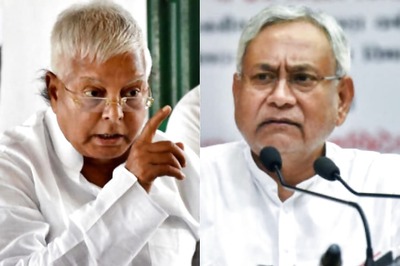
views
Bengaluru: The Indian Space Research Organisation (ISRO) on Friday said it has successfully performed the fourth lunar bound orbit manoeuvre for the Chandrayaan-2 spacecraft that is currently in the lunar orbit for its rendezvous with the moon.
All spacecraft parameters are normal, the Bengaluru-headquartered space agency said after the manoeuvre on the spacecraft.
"The fourth lunar-bound orbit manoeuvre for Chandrayaan-2 spacecraft was performed successfully today (August 30, 2019) beginning at 1818 hours IST as planned, using the onboard propulsion system. The duration of the manoeuvre was 1155 seconds. The orbit achieved is 124 km x 164 km," the space agency said in an update.
The next lunar-bound orbit manoeuvre is scheduled on September 1 between 6pm-7pm.
In a major milestone for India's second moon mission, the Chandrayaan-2 spacecraft had successfully entered the lunar orbit on August 20 by performing Lunar Orbit Insertion (LOI) manoeuvre.
There will be one more orbit manoeuvre on Sunday to make the spacecraft enter its final orbit, passing over the lunar pole at a distance of about 100 km from the moon's surface.
ISRO has said subsequently the lander will separate from the Orbiter (on September 2) and enter into a 100 km X 30 km orbit around the moon. It will then perform a series of complex braking manoeuvre to soft land in the south polar region of the moon on September 7.
ISRO Chairman K Sivan has said the proposed soft-landing on the moon was going to be a "terrifying" moment as it is something ISRO has not done before, whereas LOI manoeuvre was successfully carried out during the Chandrayaan-1 mission.
The health of the spacecraft is being continuously monitored from the Mission Operations Complex at ISRO Telemetry, Tracking and Command Network in Bengaluru with support from Indian Deep Space Network antennas at Bylalu, near Bengaluru, the space agency has said.
The Chandrayaan-2 satellite had began its journey towards the moon leaving the earth's orbit in the dark hours on August 14, after a crucial Trans Lunar Insertion manoeuvre by ISRO to place the spacecraft on "Lunar Transfer Trajectory".
India's Geosynchronous Satellite Launch Vehicle, GSLV MkIII-M1 had successfully launched the 3,840-kg Chandrayaan-2 spacecraft into the earth's orbit on July 22.
Following the landing, the rover 'Pragyan' will roll out from lander 'Vikram' and carry out experiments on the lunar surface for a period of one lunar day, equivalent to 14 earth days.
The mission life of the lander is also one lunar day while the orbiter will continue its mission for a year.
The orbiter carries eight scientific payloads for mapping the lunar surface and study the exosphere (outer atmosphere) of the moon while the lander carries three scientific payloads to conduct surface and subsurface science experiments. The rover carries two payloads to enhance the understanding of the lunar surface.
India's second lunar expedition would shed light on a completely unexplored section of the moon, its South Polar region.
According to ISRO, the mission objective of Chandrayaan-2 is to develop and demonstrate the key technologies for end-to-end lunar mission capability, including soft-landing and roving on the lunar surface.
On the science front, this mission aims to further expand the knowledge about the moon through a detailed study of its topography, mineralogy, surface chemical composition, thermo-physical characteristics and atmosphere, leading to a better understanding of the origin and evolution of the moon, the space agency had said.

















Comments
0 comment